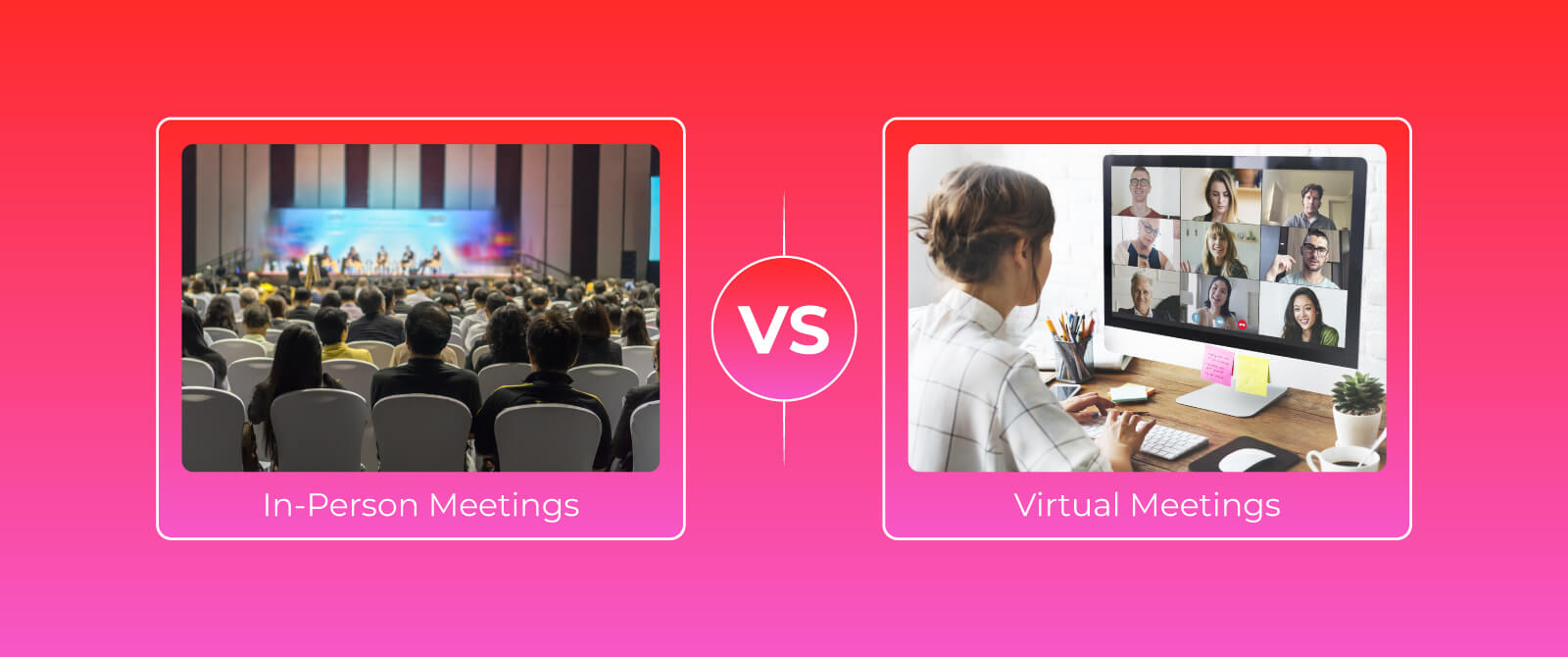Nowadays, be it large-scale companies or businesses, both are searching for efficient ways to interact, communicate, and collaborate. With technology getting innovative every hour, the debate between two formats of meetings has become popularly relevant; in-person meetings and virtual meetings. In the fast-paced world, both formats of meetings come with their own unique characteristics, benefits, and drawbacks. But the question arises: which is truly the best and most effective?
In this article, we are going to discuss the comparison between in-person and virtual meetings. We’ll explore the benefits, drawbacks, and best practices. So without further ado, let’s start:
In-Person Meetings
These gatherings refer to meetings where all the people involved in the meeting come together in one physical location. This allows participants to interact face-to-face and communicate directly. However, face-to-face meetings offer a tangible sense of presence and immediacy. The best thing about these meetings is that you can observe body language, make eye contact, and have conversations in real time.

What Are the Benefits of In-Person Meetings?
Let’s explore the amazing benefits of In-person meetings in businesses;
Personal Connection
- In-person meetings allow closeness, by this people can gauge emotions through body language and make decisions based on real-time reactions.
- To build more trust and comfort among attendees, observing facial expressions and noticing body language is enough. By these two factors, it’s easier to know about fellow attendees’ gestures.
Effective Communication
- Direct communication allows for immediate responses, promoting efficient interaction.
- Clarifying doubts instantly helps prevent misunderstandings, leading to smoother communication.
Building Relationships
- Face-to-face meetings offer opportunities to expand social circles and form bonds.
- Spending time together in person strengthens connections and increases the likelihood of maintaining relationships.
Spontaneous Collaboration
- In-person meetings encourage quick and creative teamwork.
- Being together in person makes it easier to come up with new ideas on the spot.
Non-verbal Cues
- Meeting face-to-face lets you understand how others feel without words.
- Seeing the attendee’s body language and facial expressions helps you connect with their emotions better.
Drawbacks/Challenges in Face-to-Face Meetings
Despite having benefits, in-person meetings face challenges too. Let’s explore them:
Environmental Impact
- Carbon Footprint: In-person meetings often involve travel, leading to increased carbon emissions and environmental pollution.
- Resource Consumption: The resources used in organising physical meetings, such as paper, energy, and materials, can have negative environmental effects.
Logistical Arrangements
- Venue Booking: Securing appropriate meeting spaces, particularly for large or last-minute events, can be challenging.
- Equipment Setup: Ensuring necessary equipment availability and proper functioning adds complexity to meeting preparations.
- Catering Coordination: In-person events include refreshments and meal preparations for attendees. Therefore, it requires preference-based planning, which results in additional expenses.
Time and Cost Constraints:
- Travel Expenses: Travel expenses, such as transportation, accommodation, and meals, are often associated with face-to-face meetings.
- Time Commitment: Participants must allocate considerable time to travel, disrupting their schedules and potentially affecting productivity. Additionally, travel time could be used for other tasks or personal commitments.
Understanding Virtual Meetings
A virtual meeting is a gathering that happens online instead of in person. In such meetings, participants can join from wherever they want using their computers, phones, or other devices with internet access. These meetings can be done through video chats, audio calls, webinars, or any type of online interaction.

Benefits of Virtual Meetings
Undoubtedly, virtual meetings provide numerous benefits. Be it your comfort, or expenses, these gatherings can mold accordingly. Let’s explore the benefits in detail;
Cost Savings
- By eliminating the travelling, accommodation and meal expenses, virtual meetings contribute to saving costs, which can be further used for different purposes.
- There is no need for arrangements such as meeting rooms, equipment, and office space. When you’re hosting virtual meetings, it automatically requires less investment in physical infrastructure.
- Participants can spend more time on productive activities instead of travelling to and from meetings. As a result, this will lead to increased efficiency and potentially higher revenues.
Enhanced Accessibility
- Virtual meetings also offer accessibility features such as closed captioning, screen readers, and adjustable font sizes. These features are so attendees with disabilities and mobility issues
- In virtual events, attendees are free to attend the meetings at their convenient times. These events promote inclusivity and global accessibility.
- Virtual meetings facilitate remote work arrangements by enabling employees to collaborate effectively regardless of their physical location. As a result, it enhances the work-life balance and job satisfaction.
Improved Documentation and Record-Keeping
- Many virtual meeting platforms can automatically record meetings. This ensures that all the important discussions and decisions are captured for future use.
- One of the benefits of virtual events is that these events can be transcribed in real time with accurate documentation or discussions.
- Archived recordings and transcripts allow participants to review meeting content at their convenience. In this way, virtual events ensure clarity and accountability in communication and decision-making processes.
Challenges in Virtual Meetings
Here are a few of the challenges related to virtual meetings:
Technical Requirements
- Hardware Compatibility: In virtual events, compatibility problems are most common. Therefore, it’s a challenge to ensure that attendees’ devices such as computers, laptops or smartphones, are compatible with the meeting platform
- Software Updates: An updated software version is required for smooth performance. But, in some cases, participants may face challenges if they are using old or outdated software versions.
- Bandwidth Limitations: Bandwidth plays a major role, especially in virtual events for smooth delivery of content. And because of limited bandwidth availability, there’ll eventually be delays due to latency issues during virtual meetings.
- Latency Issues: Low latency is crucial for real-time interaction in virtual meetings. And technical glitches in streaming protocols like RTMP or IP streaming can disrupt the entire communication.
Technical Issues
- Internet Connectivity: Virtual meetings may face some interruptions if there’s a slow internet connection. This further hinders audio and video quality.
- Platform Compatibility: Problems with communication platforms may arise, which can make it difficult for participants to communicate and collaborate smoothly.
And that’s all with challenges in virtual events, now let’s talk about the practices to fix these;
Best Practices To Elevate In-person and Virtual Meetings
To ensure productive meetings, consider implementing the following strategies:

Clear Agenda Setting
First, set clear objectives and goals for your meeting. Create a structured agenda to ensure that meetings go as planned. Make sure to include all the relevant topics, which ensures the smooth flow of the meeting.
Technical Readiness
Prior to the meeting, verify that all participants are familiar with the chosen communication tools and address any potential technical issues to minimize disruptions during the session.
Utilize Mobile Event App
Employ a mobile event application to provide attendees with easy access to meeting schedules, speaker profiles, and supplementary materials, enhancing engagement and facilitating seamless navigation.
Microsite Development
Create or design a dedicated microsite which includes the basic details. Such as agendas, registration details, speaker bios, and additional resources. This will further streamline the communication process.
Event Registration Platform
Utilize a robust event registration platform to facilitate efficient attendee registration and management. With an ideal platform, there’s no need to worry about operations and smooth execution. It ensures accurate tracking of attendee information and preferences.
QR Code for Seamless Check-In
Implement QR code technology for swift and contactless check-in processes at in-person meetings. However, QR code-based check-in enhances attendee satisfaction and minimises wait times.
RFID/NFC/Turnstile Access
Deploy RFID, NFC technology or turnstile access systems to enhance security measures. These technologies streamline entry processes.
Encourage Interaction
Include activities like gamification which encourage active participation among attendees. It also helps in better understanding and interaction among attendees.
Utilize Interactive Features
Be it any event, in-person or virtual, a dedicated mobile event app is a must for both. With an event app, incorporate interactive elements such as live polls, surveys, GIFs, and Q&A sessions. This stimulates the engagement process and helps in knowing the insights better.
Facilitate Networking Opportunities:
To promote professional relationships and build more engagement, schedule dedicated networking sessions like virtual breakout rooms. This facilitates meaningful connections and knowledge sharing among attendees.
Feedback Mechanism
To learn about the event performance, implement a feedback mechanism. This will further help you to know about the weak points of your event. However, organizers can have an idea about what attendees like and dislike, so they can plan the next event accordingly.
Conclusion
By the end of this article, we know that in today’s business world, choosing between in-person and virtual meetings is crucial for companies everywhere. Each type has its pros and cons, affecting how well teams communicate and work together. In-person meetings let people connect personally and collaborate naturally, while virtual meetings offer convenience, savings, and better record-keeping. But whether it’s face-to-face or online, good planning, tech readiness, and active participation are key to success. Simple guidelines like setting clear agendas and using tech wisely can improve any meeting. Ultimately, the best choice depends on what goals the company has and what works best for its people.







